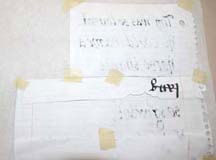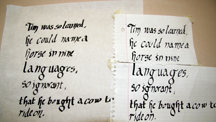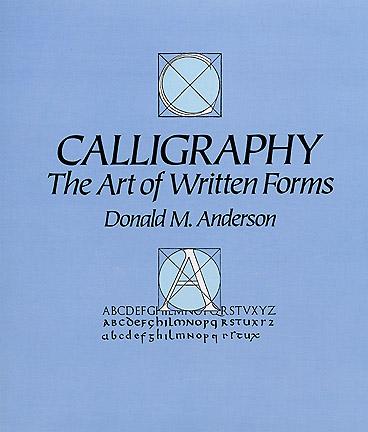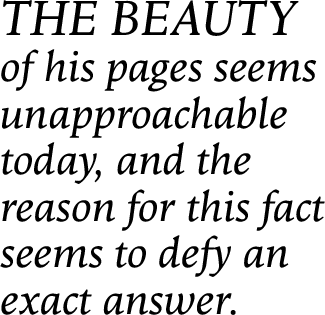Dedicated to the memory of Donald M. Anderson, renowned calligrapher, artist, author and educator.
Author of CALLIGRAPHY The Art of The Written Forms. Donald Anderson was Meryl Meisler's major professor, collaborator and friend.
|
Donald Anderson |
Dear students,
Although I never studied calligraphy formally, I did
study drawing and illustration at the University of Wisconsin at Madison
with a great authority
on illustration, Donald M. Anderson. Donald was my "major professor" in
graduate art school and taught me many things: write the way you speak,
draw what you see, use the right
tools
for the
job,
good art tools can last a lifetime if you take care of them, and of most
importance-
teachers
and
students
can be great friends.
Honestly, I learned calligraphy on my own, following
step-by-step books. "Believe you me", you don't need a good
handwriting to do calligraphy.
You will need some basic tools,
they can be traditional (a flattened edge of a marker or pencil, pen
and ink or brush and ink) or done with digital
tools (Macromedia Flash and a Wacom drawing tablet tablet
was used to the animated title on top of this page)
The most important thing you will need is space, physically and mentally. You will need to clear a small space on your desk or table, and a quiet space in your mind to calmly practice your hand at calligraphy. Together, we can make that time and space in class, just follow these step-by-step instructions. As you will see by the work of the 6th graders at The Institute for Collaboration in NYC, after a few short sessions you too can be creating beautiful calligraphy to express yourself.
Relax and have fun!
Sincerely,
Meryl
1. Check out some examples of calligraphy on the WWW.
Images http://images.google.com/images?q=calligraphy&hl=en&lr=&client=safari&rls=en&sa=X&oi=images&ct=title
Hebrew Calligraphy http://borshevsky.com/index.htm and http://impwriter.com/
Japanese Calligraphy http://takase.com/JapaneseCalligraphy/Traditional.htm
Persian Calligraphy http://caroun.com/Calligraphy/Calligraphy.htm
Arabic Calligraphy http://islamicart.com/main/calligraphy/index.html
Medieval Calligraphy http://courses.dce.harvard.edu/~humae105/fall97/twest/index.htm
2. Look at examples of graffiti at http://graffiti.org/
Do you think graffiti is another form of calligraphy?
Write a paragraph stating why or why not you think graffiti is another form of calligraphy,
http://gingerbooth.com/courseware/calligraphy.htm
6. Print out the following files:
Speedball Calligraphy Glossary Sheet and Letter Chart. http://speedballart.com/lessonsdlcp.asp
Printable worksheets for doing Uncial style font. http://studioarts.net/calligraphy/lesson.htm
7. Bind two pencils together to try the "Double Pencil Calligraphy" technique. http://suite101.com/article.cfm/5864/54724
8. Use the flat edge of a marker to make calligraphic strokes. Your local art supply store might sell calligraphy markers.
9. Now you are ready to try using a pen point (nib), pen holder and
ink on paper.
Here are a few tips: http://ehow.com/how_7727_learn-calligraphy.html
. You
can practice using lined notebook paper.
10. Get ready to write with calligraphy style.
Think of an inspirational saying,
some words of advice or wisdom. Choose a phrase that you think would
motivate you and/or your classmates to strive and reach their goals.
Here are
some
examples: http://goal-setting-guide.com/quote-success.html You
can choose a saying you have heard from a family member, friend, clergy
person, favorite actor, author, politician. You can make up your own
saying.




